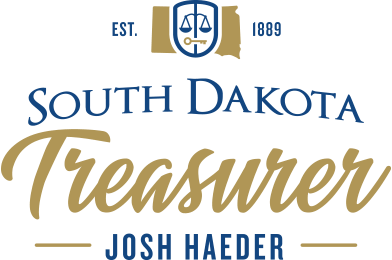We Are Here to Answer Your Questions
My institution uses an insured cash sweep product to limit our public funds exposure. Are we required to pledge collateral if there is a “lag” between when the deposit posts with our institution until it is “swept” into the network?
Yes. Per SDCL 4-6A-3, “…every qualified public depository shall at all times maintain, segregated from its other assets, eligible collateral having a value at least equal to its maximum liability under this chapter.”
Does my institution need to maintain adequate collateral to pledge for public funds each day, or only on the quarter-end date when we complete the Quarterly Report Form?
Adequate collateral must be maintained every day. Refer to the answer for question 1.
My institution is chartered out-of-state and does not have a physical location in South Dakota. Are we able to accept public deposits from South Dakota entities?
No. Per SDCL 4-6A-7, a “qualified public depository” must be located in South Dakota.
My institution is not chartered in South Dakota, but we have a branch bank there and are considered a “qualified public depository” as noted above. Do we need to follow the South Dakota public funds pledging rules, or the rules in our home state?
“Public deposit” is defined in SDCL 4-6A.1 as “all general, special, and other funds held or administered by this state or any political subdivision thereof…”. Therefore, any South Dakota public deposits must be pledged for in accordance with South Dakota law.
My institution is chartered in South Dakota, but we accept out-of-state public deposits. Do South Dakota laws apply for our out-of-state public deposits?
No. You should follow applicable laws and rules for the state that the public deposits are domiciled in.
We are unsure which deposits are considered public. Do you maintain a list of public depositors?
No. SDCL 4-6A-6 defines “public deposits” as “all general, special, and other funds held or administered by this state or any political subdivision thereof, including counties, municipalities, townships, and school districts, or by any officer, commission, board, bureau, or agency of the state or political subdivision or any tribal government funds, and which public deposit is insured, in whole or in part, by deposit insurance.”
Is my institution able to pledge the portions of loans unconditionally guaranteed by a United State Government Agency as collateral?
Yes. Per SDCL 4-6A-1, “Eligible collateral” includes “…that portion of loans which are unconditionally guaranteed by a United States government agency…”
Is my institution able to pledge revenue bonds as collateral?
No. Revenue bonds are not an acceptable form of collateral under SDCL 4-6A-1.
What loan information do I need to submit to pledge loans unconditionally guaranteed by a United States Government Agency as collateral?
Please submit the following information for each loan: Borrower Name; Loan Number; Guaranty Amount (as a $ amount); US Government Agency guaranteeing the loan; Maturity Date.
I don’t see a line on the Quarterly Report form to report loans as collateral, how should I provide this information?
The Quarterly Liability Report Form now includes Line 16e to report government guaranteed loans. Please begin using this form immediately. An updated Quarterly Liability Report Form can be found on the South Dakota State Treasurer’s website at sdtreasurer.gov/transparency/public-deposits.
Is a “Single Security” issued by Freddie Mac and Fannie Mae an acceptable form of collateral to pledge?
Currently, SDCL 4-6A-1(3) language does not specifically address Single Security offerings as “Eligible collateral”. A Qualified Public Depository is required to submit to the Division of Banking specific information on the Single Security including, but not limited to,
- A detailed description of your reasoning as to why the referenced security is eligible collateral pursuant to SDCL 4-6A-1(3);
- Prospectus for the security; and,
- Documentation showing that the security is unconditionally guaranteed by a United States Government Agency.
What does “CBI Number” in the Label section of the Quarterly Report Form stand for?
This is the reporting bank’s routing number.
